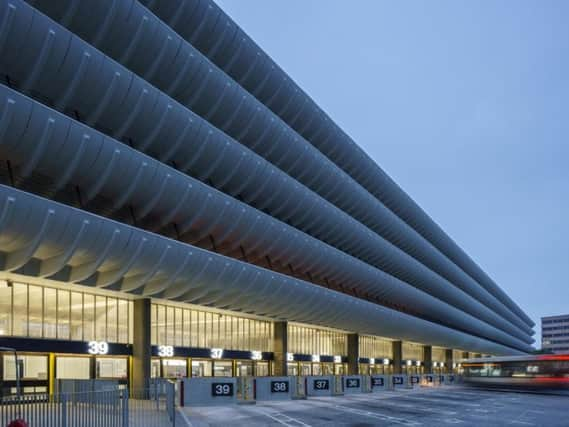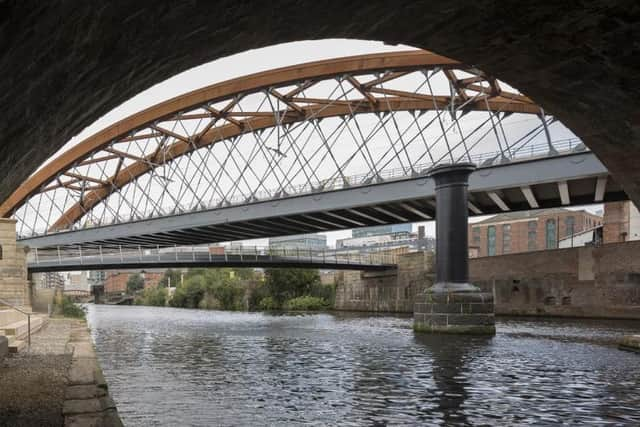Preston bus station honoured at architecture awards


And the redevelopment of the iconic building also took Royal Institute of British Architecture (RIBA) prizes in two other categories at an awards ceremony in Manchester last night.
It was one of six buildings recognised for their excellence at the annual ceremony held at the Manchester School of Art.
Advertisement
Hide AdAdvertisement
Hide AdDespite missing out on building of the year, the refurbishment, by John Puttick Associates with Cassidy+Ashton, took a conservation award and a client award.


RIBA North West Interim Regional Director, Tom Mills, said: “This year’s jury was presented with an eclectic range of building types and site responses, two of which were on the Isle of Man.
"All of the buildings demonstrated the wealth of architectural talent in our region; and I’m so glad to see several regionally-based practices triumph. It is especially pleasing to see that the refurbishment of Preston Bus Station has received three Regional Awards through a collaborative architectural approach.
"The architect’s subtle, sophisticated and sustainable response to the conservation of this landmark building has ensured that a key Northern transport hub will remain in use for many more years to come.“
Advertisement
Hide AdAdvertisement
Hide AdNorth West Regional Jury Chair, Suzi Winstanley, said: “Bravery is a big theme for the North West this year!
"The broad range of skills that architects are daring to adopt and the different typologies they are choosing to experiment with are truly inspiring. The winning schemes stretch and disrupt scales and scopes – they go beyond the original project visions of the clients. Every project is unique, contextually aware of its surroundings and has environmental strategies that are integrated from inception.”
The winners are:
Building of the Year Award Ordsall Chord by BDP
Client of the Year Lancashire County Council, Preston Bus Station refurbishment by John Puttick Associates with Cassidy+Ashton
Conservation Award Preston Bus Station refurbishment by John Puttick Associates with Cassidy+Ashton
Advertisement
Hide AdAdvertisement
Hide AdEmerging Practice of the Year Award Smith Young Architects for Farnworth House
Project Architect of the Year Award sponsored by Taylor Maxwell Michael Riley of BDP for Ordsall Chord
Sustainability Award sponsored by Michelmersh A Restorative Retreat for Sartfell by Foster Lomas
The six award-winning buildings are:
A Restorative Rural Retreat for Sartfell by Foster Lomas
Alder Hey Hospital – Institute in the Park by Hopkins Architects
Farnworth House by Smith Young Architects
Mustard Tree by OMI Architects
Ordsall Chord by BDP
Advertisement
Hide AdAdvertisement
Hide AdPreston Bus Station refurbishment by John Puttick Associates with Cassidy+Ashton
Jury report: here's what the judges said about the bus station:
An apparently subtle restoration belies a significant organisational shift at this listed and iconic Preston bus station.
Shifting all bus stands to one side instead of both, relocating the coach station, providing an information hub and rationalising retail units has reinstated a legibility and reinforced the
Advertisement
Hide AdAdvertisement
Hide Adpurpose of the building. These considered interventions have improved the flow of buses and allowed for a large area of public realm to be formed without diminishing capacity or functionality.
Significant but barely visible interventions include the complete replacement of the failing aluminium curtain wall system to increase its strength and resistance to wind load with a marginal increase in depth. The original timber sliding doors to the apron, which were rotten and too heavy to close and open have been changed to aluminium in the exact pattern and scale of the originals. This allows the bus station a functionality intended at the original build that could not be delivered at the time.
The need for the relatively new skill set required for refurbishment of listed mid 20th century buildings is on the increase as elements of such buildings fail, and their functionality wanes.
This restoration has identified ways in which to resolve failures of fabric, and design details such as the heavy sliding wood framed doors and identified new technical responses that retain the architectural aesthetics and intent of the original. The design team at Preston have delivered an outstanding, exemplary conservation project, one of minimal intervention, care, attention to detail and most importantly a viable building with a long future of use.
Advertisement
Hide AdAdvertisement
Hide AdIn a project that reveals itself the more you look, the interior has been decluttered, and theoriginal intent of the building sightlines and scale have been reasserted. Signage fits to the tiled wall grid perfectly, the concrete that is cleaned just enough, the new concrete bike stands and the re-used iroko barriers that are now seating and frames to the information kiosks. Each of these small details are what makes this project sing as a conservation work.
The main sustainability dimension of Preston Bus Station is the retention of the building itself, as the embodied energy of this very large, iconic concrete building has not been squandered. Its ongoing role as the major public transport hub of the city is enhanced by attention to simple functional details in this unheated building such as the improvement to auto-operation of all access doors to increase passenger comfort and accessibility. Retying the building to the town centre via the new ground level piazza is also very important in removing barriers to access. The client and design team has addressed the integrity and durability of the structure which has been carefully restored. All these factors will ensure the longer-term sustainability of the building in both functional, technical and economic terms.
With a stand out client team and clear engagement with conservation officers and the twentieth century society, the jury believe the project is an exemplary restoration and reworking of a mid-century building.